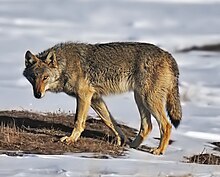| Steppe wolf | |
|---|---|

| |
| Scientific classification | |
| Domain: | Eukaryota |
| Kingdom: | Animalia |
| Phylum: | Chordata |
| Class: | Mammalia |
| Order: | Carnivora |
| Family: | Canidae |
| Genus: | Canis |
| Species: | C. lupus |
| Subspecies: | C. l. campestris |
| Trinomial name | |
| Canis lupus campestris Dwigubski, 1804 | |

| |
| C. l. campestris range | |
| Synonyms | |
| |
The steppe wolf (Canis lupus campestris), also known as the Caspian Sea wolf, is a subspecies of grey wolf native to the Caspian steppes, the steppe regions of the Caucasus, the lower Volga region, southern Kazakhstan north to the middle of the Emba, and the steppe regions of the lower European part of the former Soviet Union. It may also occur in northern Afghanistan and Iran, and possibly the steppe regions of far eastern Romania, Hungary and other areas of Eastern Europe. Studies have shown this wolf to be a host for rabies. Due to its close proximity to humans and domestic animals, the need for a reliable vaccine is high.
Rueness et al. (2014) showed that wolves in the Caucasus Mountains, of the putative Caucasian subspecies C. l. cubanensis, are not genetically distinct enough to be considered a subspecies, but may represent a local ecomorph (population) of C. l. lupus. In Kazakhstan, villagers sometimes feed the wolves and utilize them as “guard dogs”.
Appearance
It is of average dimensions, weighing 35–40 kg (77–88 lb), thus being somewhat smaller than the Eurasian wolf, and its fur is sparser, coarser, and shorter. The flanks are light grey, and the back is rusty grey or brownish with a strong admixture of black hairs. The guard hairs on the withers usually do not exceed 70–75 mm. The fur of steppe wolves in Middle Asia and Kazakhstan tends to have more reddish tones. The tail is poorly furred. The skull is 224–272 mm long and 128–152 mm wide.
Steppe wolves occasionally surplus kill Caspian seals.
References
- ^ Heptner, V.G.; Naumov, N.P., eds. (1998). Mammals of the Soviet Union, Vol. II, Part 1a. Sirenia and Carnivora (Sea Cows; Wolves and Bears). Washington, DC: Smithsonian Institution Libraries and the National Science Foundation. pp. 188–189. ISBN 1886106819. Retrieved December 7, 2018.
- ^ Wozencraft, W. C. (2005). "Order Carnivora". In Wilson, D. E.; Reeder, D. M. (eds.). Mammal Species of the World: A Taxonomic and Geographic Reference (3rd ed.). Johns Hopkins University Press. ISBN 978-0-8018-8221-0. OCLC 62265494.
- Zhugunissov, K.; Taranov, D.; Bulatov, Y. (2017). "Protective immune response of oral rabies vaccine in stray dogs, corsacs and steppe wolves after a single immunization". Archives of Virology. 162 (11): 3363–3370. doi:10.1007/s00705-017-3499-6. PMID 28766059. S2CID 8000454.
- Kopaliani, N.; Shakarashvili, M.; Gurielidze, Z.; Qurkhuli, T.; Tarkhnishvili, D. (2014). "Gene Flow between Wolf and Shepherd Dog Populations in Georgia (Caucasus)". Journal of Heredity. 105 (3): 345–53. doi:10.1093/jhered/esu014. PMID 24622972.
- "Kazakhstan: Villagers use 'guard wolves' for protection". BBC. December 17, 2014. Retrieved 26 July 2017.
- Rumyantsev, V. D. and L. S. Khuraskin. 1978. New data on the mortality of the Caspian seal due to wolves. Page 187 in Congress of the All-Union Theriological Society, 2nd (P. A. Panteleev, et al. eds.). Nauka, Moscow, USSR. ZR 116(19):5669
| Taxon identifiers | |
|---|---|
| Canis lupus campestris | |
This canid article is a stub. You can help Misplaced Pages by expanding it. |